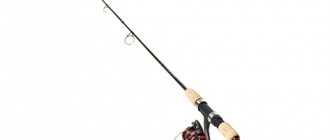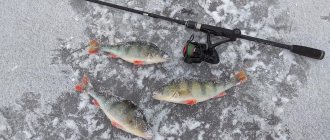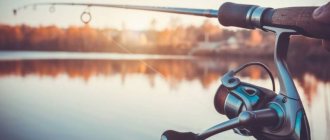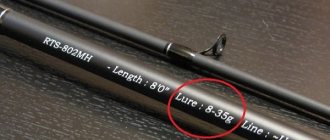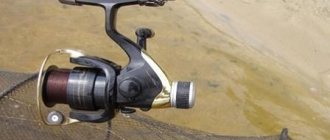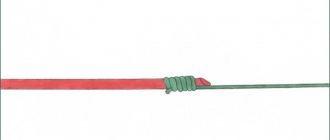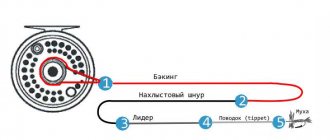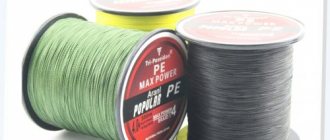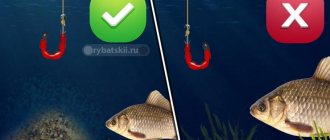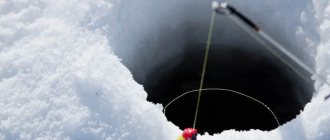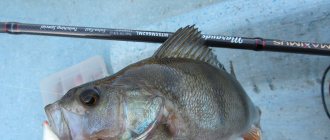Gone are the days when severe frosts quickly bound bodies of water with solid ice. Today, fishermen are looking forward to this moment, because in recent years there have been abnormally warm winters. This was the reason why spinning fishing in winter has gained wide popularity. This is still a new direction, which arose due to mild winters, but many anglers have already liked it. During this period, they go out into open water in the hope of catching pike, pike perch, perch or other predator using summer gear. On rivers, it is popular to catch chub in winter using spinning rods.
Advantages of spinning in winter:
- In winter, the predator concentrates in one place. An angler can find it after making a few casts.
- Lack of vegetation near reservoirs, which allows you to conveniently approach the water and take a comfortable position.
- Little competition.
- The catch is well preserved.
- No mosquitoes or other annoying insects.
In winter, the predator concentrates in one place.
Nuances of winter fishing:
- reduced predator activity;
- rapid freezing of the cord and rod rings;
- cold causes discomfort, hands get cold;
- it is inconvenient to move around in search of fish due to the large amount of warm clothing;
- there is no way to predict the behavior of the fish, it all depends on luck and diligent attempts;
- any change in weather negatively affects the bite.
Features of spinning fishing in cold weather
Content
The fisherman is worried about what to fish with with a spinning rod in winter. But at sub-zero temperatures, you also need to think about the safety of expensive gear. Avid spinning anglers go fishing even in severe frosts, because there are bodies of water that are not covered with ice. You must have with you:
- Rod. Modern carbon fiber and graphite “sticks” are not afraid of frost. At negative temperatures, their characteristics remain the same. This applies not only to expensive fishing rods, but also to products in the mid-price category.
- Reels. Multiplier products are suitable for fishing with a slight minus. In severe frost, the scattered water when winding up covers clothes and hands with a damp layer, which turns into an ice crust. You can use the coils we are used to, but their most vulnerable point is the overrunning clutch. For this type of fishing, it is better to choose expensive and high-quality products. In extreme cold, the lubrication of the coils thickens. This is not critical; it can always be replaced with a frost-resistant one.
Read more
How to catch grayling using a spinning rod?
In winter, monofilament freezes less
- Monofilament or "braid". In winter, monofilament freezes less. But the big drawback is that it stretches a lot. This weakens the bite force. To catch predators in winter using a spinning rod, use multi-filament cord. Give preference to products with dense weaving.
- Antifreeze for cord and rings. Water-repellent impregnation is necessary when fishing in severe frost. The cord and guide rings need to be processed. This provides protection against heavy wear and allows you to enjoy comfortable fishing.
Spinning rod equipment for wobblers for pike
Wobblers are often used by amateur spinners in the same way as spinners - on a uniform retrieve or with pauses (stop-and-go). That’s why we have a lot of fishermen who don’t like these baits - like they don’t catch with us, except when they’re hungry, when the pike takes anything. If small wobblers have already firmly settled in the boxes of our spinning rods for catching perch, chub and asp, then large ones for pike - not so much. And all because of the improper use of these baits.
Sometimes the pike takes well on even stretches of large cranks and bellies, that is, fats. However, the most effective way to catch toothy fish with this type of artificial bait is by twitching large 110, 130 or more minnow wobblers, as well as bladeless rattlins. Twitching, simply put, is fairly sharp twitching, and constantly according to a certain pattern. At the same time, the wobbler causes aggression in the pike; it grabs it to drive the competitor away from its point. Therefore, with proper wiring, wobblers catch when the pike is not feeding at all.
- Large wobblers are very stubborn when jerking - an ordinary spinning rod of medium action will bend and not pull correctly. What you need here is a powerful, but at the same time light stick with a fast or extra-fast action. That’s why large pike minnows don’t work for many novice wobbler operators; they carry them with soft spinning rods.
- The second reason for this dislike is incorrect equipment. If you attach a wobbler for twitching or a rattlin to a regular soft leash with a swivel, when jerking, the front hook of the bait will overlap the leash. And so on every wiring.
- Wobblers are a subtle bait in terms of its understanding. An important characteristic is buoyancy - slowly floating, slowly sinking, suspenders when hanging in the thickness (zero buoyancy). Suspenders (SP) are most prized by pike fish. However, a heavy leash, and even one with a swivel, can so affect the buoyancy of the wobbler that it loses its killer game.
More details - the right wobblers for pike
To properly equip a spinning rod for pike with large wobblers, you need:
- Choose the right rod - a special twitching rod or a universal one with a fast action to pull stubborn wobblers on a jerk.
- In the rig, use not soft leashes, but steel twists, which, due to their rigidity, do not overwhelm the tee of the bait when jerking.
- When making jerks, give back the tip of the rod each time, loosen the tension - only in this way will the wobbler perform those same residual vibrations and rolling that are lethal to pike.
String twist
To equip a spinning rod for pike with wobblers, we install not a soft metal leash, but a steel twist. You can make it yourself from 0.3-0.4 mm wire. In stores, twists are also sold for 100 rubles for 10 pieces. To start mastering wobblers for pike, just buy ready-made strands of 0.3 mm wire, 20 cm long, with swivels at one end.
- We tie the cord to the swivel with a palomar - a wobbler to the other end of the twist, right into the eye. We remove the factory winding ring on wobblers - it is absolutely not needed there - there will be less chance of overlaps. The weight of such leashes is not enough to impair the performance of such large pike killers as Rudra, Kanata or Ito Shiner.
- Further, when the angler dives into the wobblers and adjusts their buoyancy, by making homemade twists of different lengths (and using steel of different thicknesses), adding or removing a swivel, this characteristic can be adjusted, achieving the ideal position of the suspender.
- The twist leads can be twisted manually using pliers. After several unsuccessful attempts it will start to work. It is more convenient to do this using a screwdriver with a special attachment. But the best thing is to use a special machine, a leash, for example, from the Ramenskaya Stringa company. There you can also get a supply of the correct wire for twisting.
Knotless installation
Experienced twitchers usually catch pike only with wobblers, without using spinners. This means that a swivel is not needed in the rigging system. When equipping a spinning rod for pike with large minnows, instead of a swivel, a knotless connection is used in the equipment. The braid can simply be woven into the top twist.
However, it is safer to use a knotless clasp. The diameter of the knotless wire is 2-3 times thicker than 0.3-0.4 mm twist. Therefore, there is less pressure on the cord under load at the connection point, according to the laws of physics. And tests show that tying to a knotless knot is stronger than simply weaving into a twist or knot.
Read more: how to attach a wobbler to a spinning rod
Choosing a place for winter fishing
Not everyone knows where to find a non-freezing platform for spinning fishing in winter. It is recommended to pay attention to rivers with strong currents and nearby thermal power plants. Near them there are cooling ponds into which warm water flows. They do not become covered with ice even in severe frosts.
Snowdrifts and slush near a pond make it difficult to choose a place. At a normal rate, a small area of open water may be inaccessible. It’s easier to find a place on a river or body of water with warm water. Typical habitats of the predator:
- Channels and pits. A positive result will be obtained if these places are carefully fished.
- Edges of deep depressions. From here the predator leads the attack. Such dumps should be fished from different angles.
- Snags. This is the predator’s traditional habitat during the cold season. A good knowledge of the reservoir will allow you to reduce the number of snags.
- When fishing with a spinning rod in winter on small rivers, choose whirlpools, return lines and slow currents.
- Small areas with shell rock or uneven bottom. The predator periodically comes here to feed.
Choosing a place for winter fishing
Zander
This predator is scarce in our area, so I cannot boast of good statistics on this fish. But there were bites, the fanged ones sat on the hook and I brought them to the shore. In addition, I had to repeatedly observe the capture of pike perch by more experienced winter anglers who participate in sports competitions (including winter spinning). After each such episode, I approached and asked the fisherman what was what. This is how some theoretical developments appeared.
In winter, pike perch stays in pits. He is especially comfortable if there is a snag at the bottom. Many rate the activity of pike perch in January and February on a ten-point scale at 4 or even 3. It happens that you catch in a place where there are 100% fanged ones, you hit them on the head with a jig, and they stand at the bottom in a complete stupor, just staring at lure of the spinning angler with his bulging eyes. And they don’t bite! In this case, the only real way to get the fish to bite is to torture the fanged one, i.e. make cast after cast, performing cast after cast efficiently, waiting for the pike perch to react to the bait. Work hard and success will come to you. But the question arises: is the game worth the candle? Wouldn't it be better to spend time catching more active pike or perch? Everyone must decide for themselves...
Choosing the right clothes for winter spinning fishing
Spinning in open water in winter involves constant movement in search of fish. This must be taken into account when choosing clothes. Here you should spend money on equipment once in order to feel comfortable every fishing trip. Clothes should be:
- waterproof;
- light;
- protect from the wind;
- do not hinder movements.
There should be several layers of clothing. Thermal underwear is put on the body. For outerwear, it is recommended to use suits, which can be found in special stores. They consist of a jacket and pants and meet all the above requirements. In high-quality products, the seams are taped, the suits are reliably protected in wet weather. Clothing may consist of the following components:
- Jacket. It should have a hood with a visor and a tightening fastener. Choose products with thick, elongated cuffs. There must be a zipper. Some models have a “warm” pocket for your phone.
- Trousers. The high waist will reliably protect the lower back. Warm and thin material will not interfere with walking. Shoulder straps with adjustable length will add greater comfort. Pay attention to the models of pants that can be put on without taking off your boots.
- Shoes. Many people use lightweight foam boots. When walking intensively, your feet begin to sweat. When stopped they freeze. It is better to pay attention to shoes made of more “breathable” material.
- Vest. This accessory is easy to use and does not interfere with hand movement. Its main purpose is not to warm you up, but to unload the pockets of your main clothes. A lot of necessary little things will fit here. You can also use special bags attached to your belt.
- Mask for the face. In severe frosts, fishing with an open face will turn into a real challenge. To protect your face, you can use any knitted mask. A balaclava will be an ideal option.
Read more
What is a jig?
Clothes for winter fishing
Equipment and other nuances
When going on a winter spinning trip, the angler must be properly equipped, because every little thing can have a significant impact on the convenience of fishing and the success of fishing in general. Of course, dressing in a heavy peacoat, felt boots and wadded trousers is inadvisable, since such “equipment” will not allow you to move much around the water area and comfortably handle the gear.
For winter spinning, choose light but warm clothing. Modern suits made of membrane fabric, consisting of overalls and a jacket, have proven themselves to be excellent. They are light in weight, do not restrict movement, do not get wet and perfectly remove moisture from the body.
A warm, windproof hat is a must. A fleece hat with windproof inserts is suitable. It warms well and does not allow you to sweat, removing condensation outside. To prevent your hands from freezing, you need to buy gloves and mittens. This is the best option, allowing you to warm your fingers if necessary, completely hiding them in the heat.
Before going to a pond, it is very important to develop in advance a travel route to promising points and an approximate fishing plan. In winter, these nuances can be decisive and affect both the fishing result and the health of the spinning fisher
https://rybalke.net/zimniy-spinninghttps://rybalka.guru/spinning/lovlya-na-spinning-zimojhttps://fishelovka.ru/gear/o-zimnem-spinninge
Choosing gear for catching predators in winter using a spinning rod
Spinning fishing in winter will be comfortable at zero temperatures or slight minuses. In severe frost, few people engage in spinning fishing. If you dare to do this, you need to consider some factors:
- rod Don't ruin your expensive rod at -20. For these purposes, choose a budget “stick” with large rings;
- the coil must be a closed type. The grease may freeze. Here you need to use antifreeze recommended by the coil manufacturer;
- fishing line The rapid freezing of monofilament forces you to opt for braided line. It must be well laid. The formation of a “beard” in the cold is doubly unpleasant. There are many brands of frost-resistant cords;
- bait. The classic bait is a spinner. It shows good results and should always be in the angler’s arsenal. Spinning jig fishing in winter is also very popular. Such bait can imitate the color, shape and smell of prey. Due to the low activity of the predator, the wiring should be slow.
Silicone baits for perch
Spinning anglers know well how much perch loves silicone baits. In winter, their range should be expanded. This is not the case in the summer, when it is enough to have 3-4 twisters and vibrotails and with them you can claim trophies. In winter, perch is very picky. Even during one fishing trip, he can initially react well to a small twister, and then his preferences change in favor of worms, slugs and other baits.
You should not use large baits, as the perch will not respond to them. Always remember that bass have a small mouth and are simply not comfortable swallowing large baits. Very often, a school of perches chases unwary bleaks, while ignoring small roaches. This is understandable, because the bleaks are narrow and easier to swallow. As for the color of silicones, it is best to give preference to dark baits rather than bright ones.
When fishing for perch in winter, it is better to use a silicone hook on a retractable leash. It will come in handy during reconnaissance of a place, when you need to determine the number of perch at a point. With the help of a retractable leash it is easy to perform fast and slow retrieving. If you fish with the current, you can play the bait at one point.
The rig with a lead looks like this:
We see that a swivel is attached to the main line, to which two leashes are attached. One with bait, and the second with a sinker. The diameter of the fishing line for the sinker should be three times thicker than the main one. The leash for silicone should have a thickness of 0.2 mm and be fluorocarbon. Its length varies from 60 to 120 cm. Such tackle will not get tangled, and we will avoid overlaps. It is best to use a pear-shaped or ball-shaped sinker.
The use of water-repellent agents when fishing with spinning rods in winter
Freezing of the cord leads to a decrease in its strength. The fragile “braid” breaks with a slight bite. When fishing in winter it is necessary to use water-repellent compounds. This also applies to pass rings. Freezing over, they cut the cord. Several products can be used for lubrication:
- fishing liquid silicone;
- lubricant for fly fishing flies;
- goose fat;
- Vaseline oil;
- special branded compositions.
It is recommended to lubricate the line and rings every ten casts.
